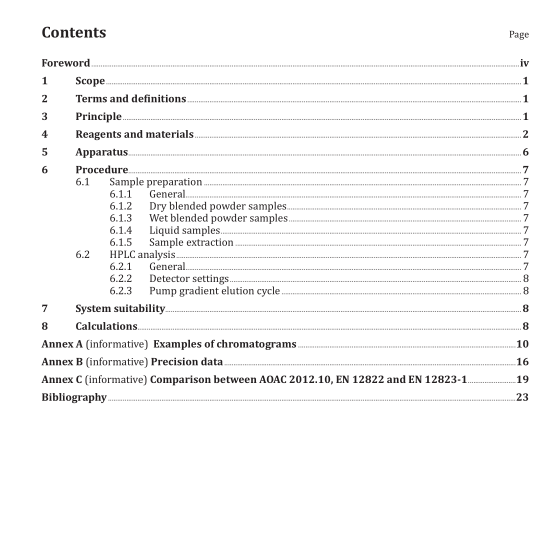BS ISO 20633:2015 pdf download.Infant formula and adult nutritionals — Determination of vitamin E and vitamin A by normal phase high performance liquid chromatography.
4 Reagents and materials
During the analysis, unless otherwise stated, use only reagents of recognized analytical grade and distilled or demineralized water or water of equivalent purity.
4.1 Methyl-t-butyl ether, also known as tert-butylmethylether, HPLC grade.
4.2 n-Hexane, HPLC grade.
4.3 Ethanol, HPLC grade.
4.4 Methanol, HPLC grade.
4.5 Iso-octane (2,2,4-trimethylpentane), HPLC grade.
4.6 Papain (from Carica papaya), ≥ 3 U/mg, Sigma 76220 1) or equivalent.
4.7 Hydroquinone, Sigma H9003 1) or equivalent.
4.8 Glacial acetic acid, analytical reagent grade.
4.9 Anhydrous sodium acetate.
4.10 Dilute hydrochloric acid solution.
Dilute 100 ml of a hydrochloric acid solution with a mass fraction of 36 % to 200 ml with water.
4.11 Papain solution, mass concentration ρ = 20 g/l.
Dissolve 100 mg hydroquinone and 4 g anhydrous sodium acetate in approximately 80 ml of water in a 100 ml one-mark volumetric flask (5.11). Adjust the pH to 5,0 with dilute hydrochloric acid solution (4.10). Add 2 g of papain and make up to volume. Prepare fresh prior to use.
4.12? Acidified? methanol? solution.
Add 20 ml of glacial acetic acid to 1 l of methanol and mix. Prepare fresh on the day of use.
4.13 HPLC mobile phase A.
n-Hexane, filtered and degassed for 15 min in an ultrasonic bath.
4.14 HPLC mobile phase B.
Mix 750 ml of n-hexane with 250 ml of methyl-t-butyl ether. Add 3 ml of methanol, filter and degas for 15 min in an ultrasonic bath.
4.15 Standard substances
4.15.1 Retinyl palmitate reference standard, primary reference standard. The standard shall contain antioxidant. CAS 78-81-2.
4.15.2 Retinyl acetate reference standard, primary reference standard. CAS 127-47-9.
4.15.3? α-tocopheryl? acetate? reference? standard, primary reference standard. CAS 7695-91-2
4.15.4? α-tocopherol? reference? standard, primary reference standard. CAS 10191-41-0.
4.16 Standard solutions
4.16.1 Retinyl palmitate stock standard solution.
Weigh to the nearest 0,01 mg, approximately 70 mg of retinyl palmitate (4.15.1) into a 50 ml volumetric flask (5.11). Dissolve in and dilute to volume with iso-octane (4.5).
4.16.2 Retinyl acetate stock standard solution.
Weigh, to the nearest 0,01 mg, approximately 35 mg of retinyl acetate (4.15.2) into a 50 ml volumetric flask (5.11). Dissolve in and dilute to volume with ethanol (4.3).
4.16.3 α-tocopheryl acetate stock standard solution.
Weigh, to the nearest 0,01 mg, approximately 180 mg of α-tocopheryl acetate (4.15.3) into a 50 ml volumetric flask (5.11). Dissolve in and dilute to volume with iso-octane.
4.16.4 α-tocopherol stock standard solution.
Weigh, to the nearest 0,01 mg, approximately 100 mg of α-tocopherol (4.15.4) into a 50 ml volumetric flask (5.11). Dissolve in and dilute to volume with iso-octane.
NOTE The above stock standard solutions are stable in a refrigerator at 4 °C to 8 °C for up to 7 days.
4.16.5 Combined working standard solution 1.
Transfer by pipette 4 ml of retinyl palmitate stock standard solution (4.16.1), 4 ml of retinyl acetate stock standard solution (4.16.2), 7 ml of α-tocopheryl acetate stock standard solution (4.16.3) and 20 ml of α-tocopherol stock standard solution (4.16.4), into a 50 ml volumetric flask (5.11) and dilute to volume with iso-octane. Prepare this solution freshly prior to use.
4.16.6 Combined working standard solution 2.
Transfer by pipette 8 ml of combined working standard solution 1 (4.16.5) into a 100 ml volumetric flask (5.11) and dilute to volume with iso-octane. Prepare this solution freshly prior to use.
4.16.7 Calibration standard solutions
Into separate 50 ml volumetric flasks (5.11), transfer by pipette 0,5 ml, 2 ml, 4 ml, 8 ml, 16 ml and 32 ml of combined working standard solution 2 (4.16.6), and dilute to volume with iso-octane. These solutions are used to construct a multipoint calibration curve. Prepare these solutions daily prior to use.
NOTE For routine testing and depending on the concentration range of the analytes in the test samples, a 3 or 4 point standard curve can be used, provided the ranges are within the lowest and highest points of the 6 point curve listed above.
4.17 Stock standard purity determinations
4.17.1 Spectrometric purity of retinyl palmitate stock solution
Pipet 1 ml of retinyl palmitate stock standard solution (4.16.1) into a 100 ml volumetric flask (5.11) and make up to volume with ethanol. Determine the absorption at 325 nm, zeroed against ethanol in a 1 cm quartz cell. Repeat the reading a further two times, rinsing the sample cuvette with the solution before each reading. Calculate the average absorbance reading. Calculate the spectrometric purity as a decimal, SP RP , of retinyl palmitate using Formula (1):
where
A is the average absorbance reading;
975 is the extinction coefficient of retinyl palmitate at 325 nm (see Reference [1]);
m st is the mass of the reference standard in mg.BS ISO 20633 pdf download.BS ISO 20633 pdf download
